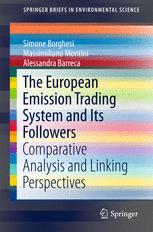Since its introduction, the European Emission Trading System (EU ETS) imme- diately gained attention from scholars and policy-makers as it was the first trans- boundary cap and trade scheme and the largest air ETS in the world. For these reasons, it was commonly regarded as a “prototype” for the other ETSs established at national level around the world (Ellerman 2010). Through the years, the EU ETS has progressively gained a paramount position within the EU climate change legislation and currently represents the most striking flagship in this sector, with more than 11.000 installations covered by the scheme. In parallel, the EU ETS has paved the way for the establishment of many other ETSs in several jurisdictions. Such schemes are now recognised worldwide as the “cornerstones” of the climate change policy, especially in the view of the lengthy and difficult process of the international climate change multilateral negotiations. This chapter presents and analyses the EU ETS in a legal and economic per- spective, with the view to assess whether it has truly represented a prototype for the other ETSs established around the world. To this end, the analysis firstly focuses on the most relevant legislative framework and technical aspects of the EU cap and trade scheme, in order to better understand its purpose, structure and features (see Sects. 1.2–1.9). Secondly, the evolution of carbon price and the economic and environmental effectiveness of the EU ETS are examined, so as to assess the real performance of the EU ETS and evaluate its suitability to act as a model for other national or regional ETSs (see Sects. 1.10 and 1.11). Finally, attention is devoted to the structural reform proposals that have been advanced to improve the functioning of the EU ETS in response to the difficulties encountered by the system in the last few years (see Sect. 1.12)
چکیده فارسی
از زمان معرفی، سیستم تجارت انتشار اروپا (EU ETS) بلافاصله توجه محققان و سیاست گذاران را به خود جلب کرد زیرا این اولین طرح سقف و تجارت فرامرزی و بزرگترین ETS هوایی در جهان بود. به این دلایل، معمولاً به عنوان یک "نمونه اولیه" برای سایر ETS های تاسیس شده در سطح ملی در سراسر جهان در نظر گرفته می شود (Ellerman 2010). در طول سالها، EU ETS به تدریج جایگاه مهمی را در قانون تغییرات آب و هوایی اتحادیه اروپا به دست آورده است و در حال حاضر با بیش از 11000 تاسیسات تحت پوشش این طرح، برجستهترین پرچمدار در این بخش است. به موازات آن، EU ETS راه را برای ایجاد بسیاری از ETS های دیگر در چندین حوزه قضایی هموار کرده است. چنین طرح هایی اکنون در سراسر جهان به عنوان "سنگ های اساسی" سیاست تغییر اقلیم به رسمیت شناخته می شوند، به ویژه با توجه به روند طولانی و دشوار مذاکرات بین المللی چندجانبه تغییرات آب و هوا. این فصل ETS اتحادیه اروپا را از منظر حقوقی و اقتصادی ارائه و تجزیه و تحلیل میکند تا ارزیابی کند که آیا واقعاً یک نمونه اولیه برای سایر ETSهای تأسیس شده در سراسر جهان است یا خیر. برای این منظور، تجزیه و تحلیل ابتدا بر مرتبطترین چارچوب قانونی و جنبههای فنی طرح تجاری و سقف اتحادیه اروپا متمرکز است تا هدف، ساختار و ویژگیهای آن را بهتر درک کند (به بخشهای 1.2-1.9 مراجعه کنید). در مرحله دوم، تکامل قیمت کربن و اثربخشی اقتصادی و زیستمحیطی EU ETS مورد بررسی قرار میگیرد تا عملکرد واقعی ETS اتحادیه اروپا ارزیابی شود و مناسب بودن آن برای عمل به عنوان مدلی برای سایر ETSهای ملی یا منطقهای ارزیابی شود (به بخشها مراجعه کنید. 1.10 و 1.11). در نهایت، توجه به پیشنهادات اصلاح ساختاری که برای بهبود عملکرد EU ETS در پاسخ به مشکلاتی که سیستم در چند سال اخیر با آن مواجه شده است، ارائه شده است (به بخش 1.12 مراجعه کنید)
ادامه ...
بستن ...
Author(s): Simone Borghesi, Massimiliano Montini, Alessandra Barreca (auth.)
Series: SpringerBriefs in Environmental Science
Publisher: Springer International Publishing, Year: 2016
ISBN: 978-3-319-31185-2, 978-3-319-31186-9
ادامه ...
بستن ...










